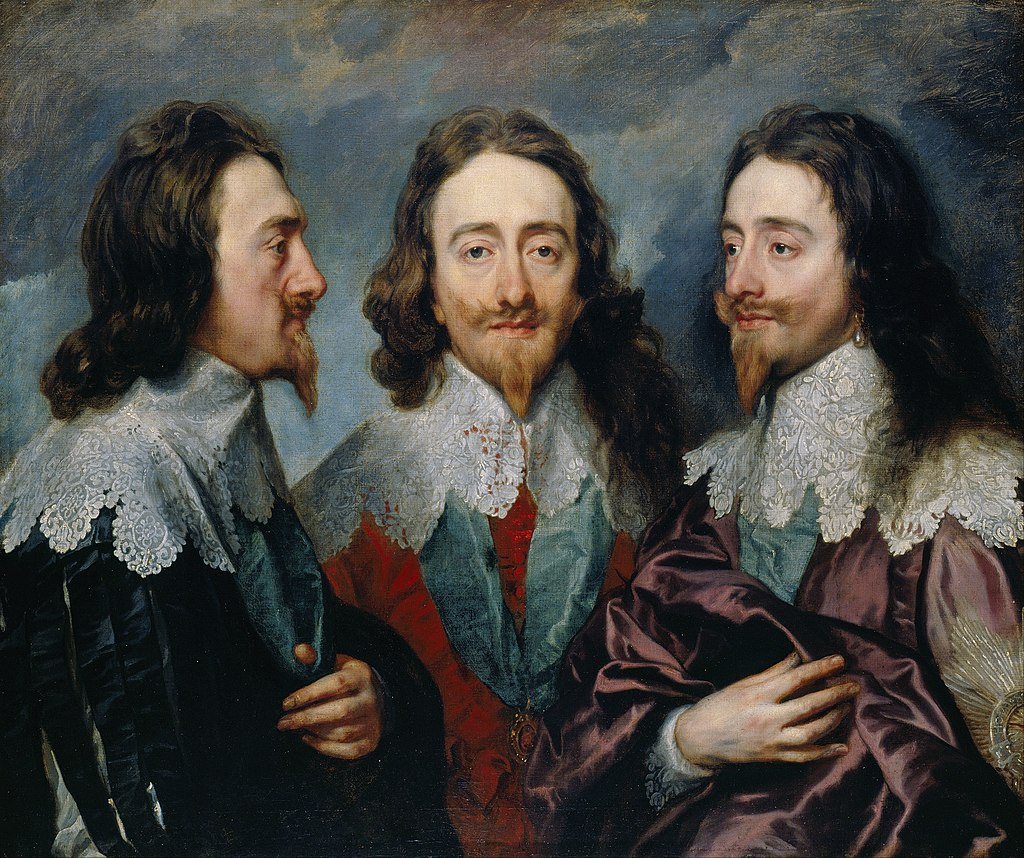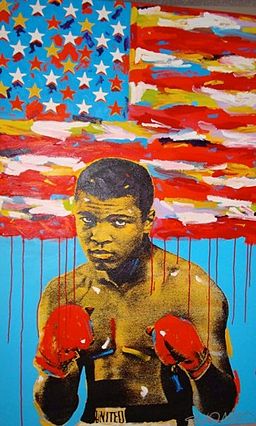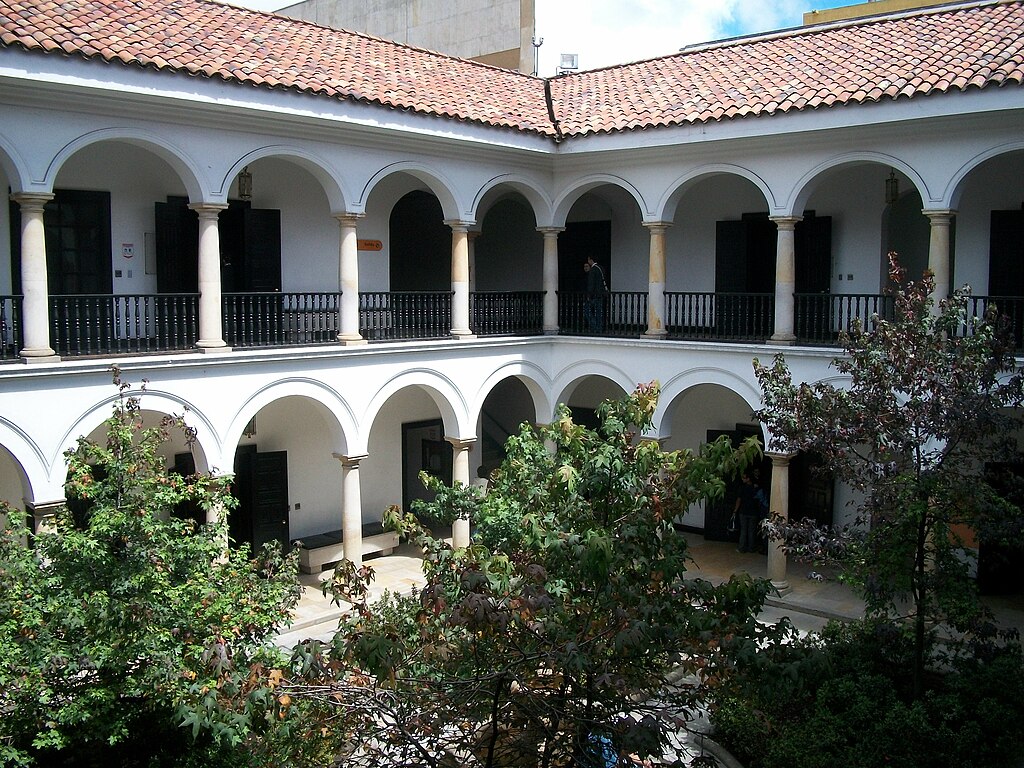
“Triple Portrait of Charles I” by Anthony Van Dyck shows the King from three viewpoints: left full profile, face on, and right three-quarter profile. The colors of the costumes and the delicate pattern of the lace collars are different in each portrait. The blue ribbon of the Order of the Garter appears in all three. The King also displays the fashion of the day in which men wore their hair longer on the left side.
The heads in the painting are drawn and modeled with great care by Van Dyck. The purpose for the picture was for it to be used as a reference work by Bernini in Italy to create a marble bust of Charles I. However, the contrast color of the blue Garter ribbon with the three different colors of the King’s costume plus the beautifully patterned lace collars have turned this reference work into a masterful artwork.
Van Dyck had been influenced by the “Triple Portrait of a Goldsmith” by Lorenzo Lotto (1530), which was in Charles I’s collection at this time. The King’s portrait, in turn, influenced the “Triple Portrait of Cardinal de Richelieu” by Philippe de Champaigne (1642), also created to assist Bernini with a bust of the Cardinal.
After Bernini completed the marble bust of Charles I, Pope Urban VIII sent the statue to Charles’s Queen Henrietta Maria in the hope of encouraging a reconciliation of the Roman Catholic Church with the Church of England.
The King and Queen much admired the bust for its likeness to the King. Charles rewarded Bernini with a diamond ring. The Queen then commissioned Bernini to make a companion bust of her, but the English Civil War intervened, and it was never made. The Charles I bust was destroyed by a fire in Whitehall Palace in 1698.
Bernini and his heirs kept the painting in their possession until 1802 when it returned to England. It was acquired for the Royal Collection in 1822. Also, several copies of this work were made for supporters of the royal House of Stuart, including one now in the collection of the Victoria and Albert Museum in London.
Charles I of England
Charles I (1600 – 1649) was monarch from 1625, and soon after his succession, Charles quarreled with the Parliament of England, which sought to curb his royal prerogative. Charles believed in the divine right of kings and thought he could govern according to his conscience. Many of his subjects opposed his policies, which led to the English Civil War.
After his defeat in 1645, Charles refused to accept his captors’ demands for a constitutional monarchy and was tried, convicted, and executed for high treason in 1649. The monarchy was abolished, and a republic called the Commonwealth of England was declared. The monarchy was later restored to Charles’s son, Charles II, in 1660.
Anthony van Dyck
Sir Anthony van Dyck (1599 – 1641) was a Flemish artist who became the leading court painter in England after success in the Southern Netherlands and Italy. Van Dyck started painting from an early age. He gained early success as a painter, becoming a master in the Antwerp guild in 1618. He worked in the studio of Peter Paul Rubens, who became a significant influence on his work.
Van Dyck worked in London for some months in 1621, then returned to Flanders for a brief time, before traveling to Italy, where he stayed until 1627. He spent five years after his return from Italy in Flanders, and from 1630 was the court painter for Archduchess Isabella, Habsburg Governor of Flanders. In 1632 he returned to London to be the principal court painter at the request of Charles I of England.
He is best known for his portraits of European aristocracy, most notably Charles I and his family and associates. He also painted mythological and biblical subjects, including altarpieces, and was an important innovator in watercolor and etching. Charles I granted him a knighthood, and he was buried in St Paul’s Cathedral.
Triple Portrait of Charles I
- Title: Triple Portrait of Charles I
- Also: Charles I in Three Positions
- Artist: Anthony van Dyck
- Year: 1635
- Medium: Oil on canvas
- Dimensions: Height: 84.4 cm (33.2″); Width: 99.4 cm (39.1″)
- Museum: Royal Collection
Anthony van Dyck
- Name: Anthony van Dyck
- Birth: 1599 – Antwerp, Spanish Netherlands (modern-day Belgium)
- Died: 1641 (aged 42) – London
- Nationality: Flemish
- Movement: Baroque
- Notable Works:
- Equestrian Portrait of Charles I
- Charles I at the Hunt
- Triple Portrait of Charles I
- Biblical Subjects by Anthony van Dyck
- Samson and Delilah
- Christ Crowned with Thorns
- The Rest on The Flight into Egypt
A Virtual Tour of Triple Portraits
- “Triple Portrait of Cardinal de Richelieu” by Philippe de Champaigne
- “Triple Portrait of Charles I” by Anthony Van Dyck
- “Triple Portrait of a Goldsmith” by Lorenzo Lotto
- “Allegory of Time Governed by Prudence” by Titian
A Virtual Tour of the Queen’s Gallery and the Royal Collection
- “Lady at the Virginal with a Gentleman,” ‘The Music Lesson’ by Johannes Vermeer
- “Massacre of the Innocents” by Pieter Bruegel the Elder
- “Courtyard in Delft at Evening: a Woman Spinning” by Pieter de Hooch
- Self-Portrait as the Allegory of Painting” by Artemisia Gentileschi
- “Cupid and Psyche” by Anthony van Dyck
- “Triple Portrait of Charles I” by Anthony Van Dyck
~~~
“Democracy is the power of equal votes for unequal minds.”
– Charles I of England
~~~
Photo Credit: 1) Anthony van Dyck [Public domain]; Royal Collection / Public domain
Popular this Week








 Sponsor your Favorite Page
Sponsor your Favorite Page SEARCH Search for: Search Follow UsJoin – The JOM Membership Program
Sponsor a Masterpiece with YOUR NAME CHOICE for $5
Share this:
- Tweet
